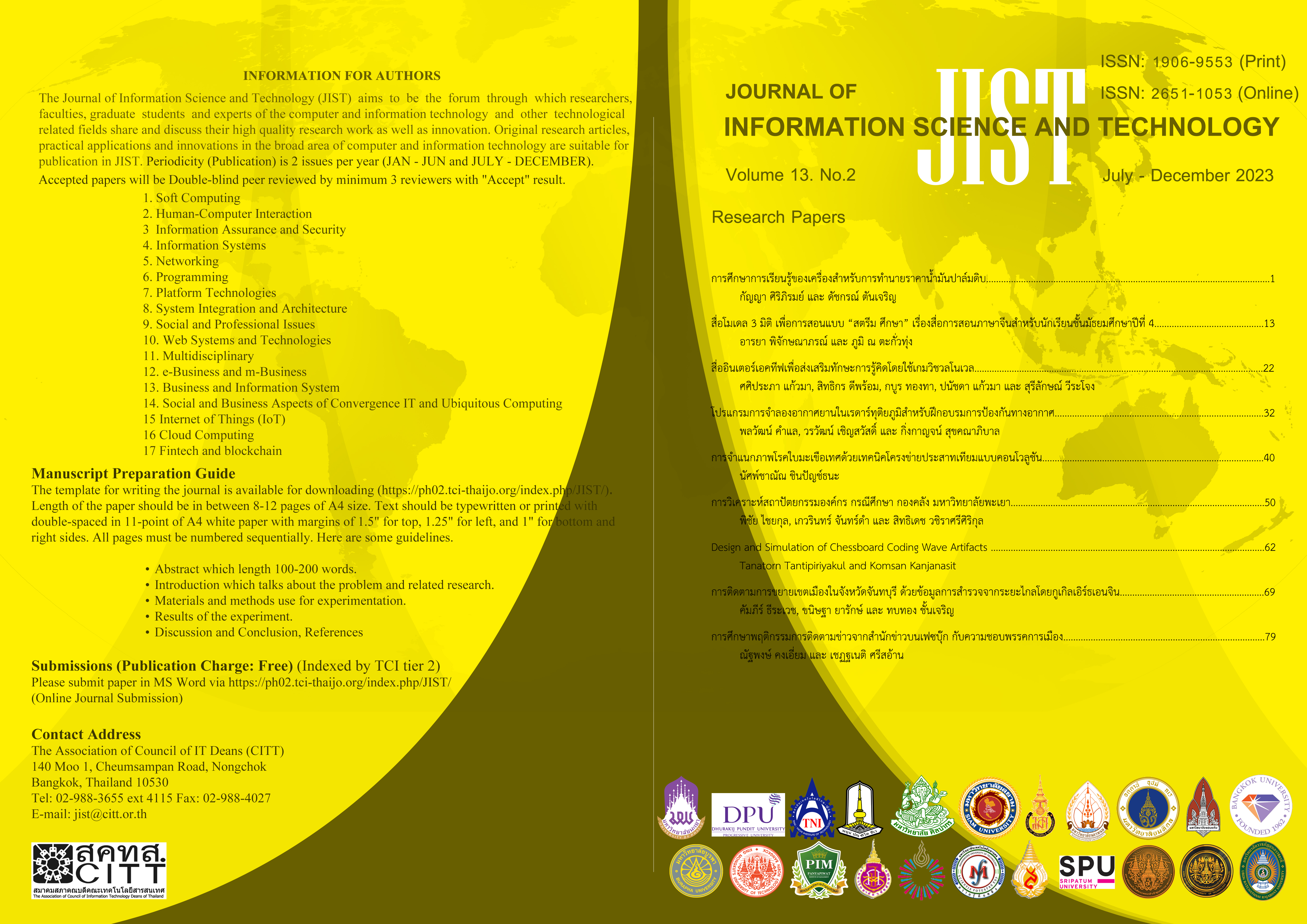โปรแกรมการจำลองอากาศยานในเรดาร์ทุติยภูมิสำหรับฝึกอบรม การป้องกันทางอากาศ
Main Article Content
บทคัดย่อ
บทความนี้นำเสนอโปรแกรมการจำลองอากาศยานในเรดาร์ทุติยภูมิสำหรับฝึกอบรมการป้องกันทางอากาศ โปรแกรมนี้ใช้กับระบบเรดาร์พิสัยใกล้และพิสัยกลางเป็นส่วนสำคัญที่ช่วยให้เจ้าหน้าที่สามารถฝึกฝนทักษะการตรวจจับเรดาร์ได้โดยไม่จำเป็นต้องนำเครื่องบินขึ้นบินจริงเพื่อฝึกซ้อม โดยโปรแกรมจำลองนี้สามารถจำลองสถานการณ์ต่างๆ ได้ เช่น การฝึกซ้อมด้วยเรดาร์หลายตัวและในสถานการณ์จริงที่มีจำนวนอากาศยานที่หนาแน่นได้ บทความนี้นำเสนอนวัตกรรมใหม่ที่ใช้โปรแกรมจำลองอากาศยานในเรดาร์ที่สังเคราะห์จากข้อมูลจริงที่เก็บรวบรวมจาก FlightRadar24 โดยตัวโปรแกรมมีคุณสมบัติดังนี้ 1) จำลองข้อมูลที่เก็บรวบรวมจาก FlightRadar24 2) จำลองข้อมูลจากเทคนิคการสังเคราะห์สัญญาณรบกวน (noise synthesis) 3) จำลองข้อมูลที่หลากหลายโดยใช้เทคนิคแบบสังเคราะห์เดี่ยว และสังเคราะห์ความหนาแน่นของการจราจรทางอากาศ ผลการทดลองชี้ให้เห็นว่าระบบสามารถนำโปรแกรมจำลองนี้ไปใช้จริงกับระบบป้องกันภัยทางอากาศได้
Article Details
This work is licensed under a Creative Commons Attribution-NonCommercial-NoDerivatives 4.0 International License.
I/we certify that I/we have participated sufficiently in the intellectual content, conception and design of this work or the analysis and interpretation of the data (when applicable), as well as the writing of the manuscript, to take public responsibility for it and have agreed to have my/our name listed as a contributor. I/we believe the manuscript represents valid work. Neither this manuscript nor one with substantially similar content under my/our authorship has been published or is being considered for publication elsewhere, except as described in the covering letter. I/we certify that all the data collected during the study is presented in this manuscript and no data from the study has been or will be published separately. I/we attest that, if requested by the editors, I/we will provide the data/information or will cooperate fully in obtaining and providing the data/information on which the manuscript is based, for examination by the editors or their assignees. Financial interests, direct or indirect, that exist or may be perceived to exist for individual contributors in connection with the content of this paper have been disclosed in the cover letter. Sources of outside support of the project are named in the cover letter.
I/We hereby transfer(s), assign(s), or otherwise convey(s) all copyright ownership, including any and all rights incidental thereto, exclusively to the Journal, in the event that such work is published by the Journal. The Journal shall own the work, including 1) copyright; 2) the right to grant permission to republish the article in whole or in part, with or without fee; 3) the right to produce preprints or reprints and translate into languages other than English for sale or free distribution; and 4) the right to republish the work in a collection of articles in any other mechanical or electronic format.
We give the rights to the corresponding author to make necessary changes as per the request of the journal, do the rest of the correspondence on our behalf and he/she will act as the guarantor for the manuscript on our behalf.
All persons who have made substantial contributions to the work reported in the manuscript, but who are not contributors, are named in the Acknowledgment and have given me/us their written permission to be named. If I/we do not include an Acknowledgment that means I/we have not received substantial contributions from non-contributors and no contributor has been omitted.
References
Hao, J., Wang, X., Yang, S., Gao, H., Yu, C., & Xing, W. (2022). Intelligent Target Design Based on Complex Target Simulation. Applied Sciences, 12(16), 8010.
Wang, S., & Liu, Y. (2020). Modeling and simulation of CGF aerial targets for simulation training. In Proc. Int. Conf. Comput. Intell. Syst. Netw. Remote Control (pp. 1-14).
Yang, P. E. N. G. (2022, April). A study on development of intelligent ground-based air defense radar under the background of modern war. In Journal of Physics: Conference Series (Vol. 2252, No. 1, p. 012068). IOP Publishing.
Jung, Y. H., & Hong, S. M. (2003). Modeling and parameter optimization of agile beam radar tracking. IEEE Transactions on Aerospace and Electronic Systems, 39(1), 13-33.
Behm, A., Borkar, V. R., Carey, M. J., Grover, R., Li, C., Onose, N., ... & Tsotras, V. J. (2011). Asterix: towards a scalable, semistructured data platform for evolving-world models. Distributed and Parallel Databases, 29, 185-216.
EOUROCONTROL: All-purpose structured EUROCONTROL surveillance information exchange (ASTERIX). https://www.eurocontrol.int/asterix (Accesed 11 June 2023).
Eurocontrol, CAT048 - EUROCONTROL Specification for Surveillance Data Exchange ASTERIX Part 4 Category 48 https://www.eurocontrol.int/publication/cat048-eurocontrol-specification-surveillance-data-exchange-asterix-part4 (Accesed 11 June 2023).
Khamsalee, P., Mesawad, P., & Wongsan, R. (2020). Hybrid metamaterial for the secondary radar antenna system. Journal of Electromagnetic Engineering and Science, 20(3), 221-233.
Mumford, R. (2005). EADS supplies radar and weapon coordination systems to the Netherlands. Microwave Journal, 48(5), 147-148.


